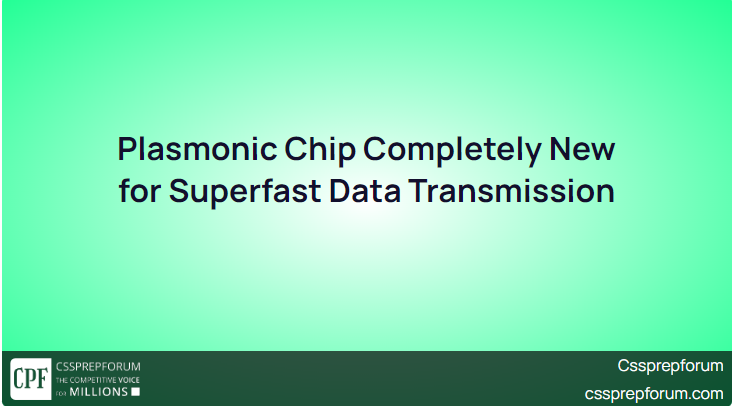Written by Anum Saba
The work from the past 20 years the researchers were trying to achieve has now achieved by ETH Zurich. In their laboratory work which was a part of European Horizon 2020 research projects, they have manufactured a chip on which speedy electronic signals can be converted directly into ultrafast light signals in which practically the quality of the signal will not lose. This work turns out to be worthwhile for optic communication, which uses light for transmission of data.
It is currently deployed in Zurich for the faster transmission of data whereas at the end of this decade it will reach its extend. This invention will be helpful due to an increased usage of online services for a wide range such as computation and all other works, which can be done online. The speed of today’s transportation of data is working on gigabits, and in the near future, it will move to terabit.
Electronics as well as light on the same chip
Necessity is the mother of invention. Same applies here in which photonics where they shift horizons to light and electronics. It is a huge step in which a single chip contains both electronic and light elements, whereas the currently used chips contain both of them on separate chips and then combined with wires. However, it has many consequences, such as cost and speed factors.
Compact size for maximum speed
Quality of data is being lost while connecting both chips for transmission, which in result reduces the speed. Now in this new chip, there is modulator used to combine both on a single chip and the modulator’s size is as small as possible to avoid loss intensity and quality of signals. Compactness is gained by tightly placing the electronic and photonic components like layers and directly connected to the chip. It helps in reducing the loss of signal quality and shortens transmission path. This approach is known as “Monolithic co-integration.” For the past twenty years, scientists could not combine it because of the large size of photonic chips than electronics chips. It is now possible with the help of metal oxide semiconductor (CMOS) technology.
Plasmonic: magical potion for semiconductor chips
The size differences are now overcome with the help of plasmonics, a branch of photonics, that provide the basis for ultrafast chips. It squeezes the light waves into structures which are much smaller than the actual wavelength of the light. As the plasmonic chips are smaller than the electronic chips, it becomes possible to manufacture more compact chips. A plasmonic intensity modulator is used to convert electrical signals faster and based on a metal structure.
Combined for record speed
It is also an achievement in the greater transmission speed with the help of ‘4:1 multiplexing’ to form high-speed electrical signals. This process enabled data transmission at a rate of over 100 gigabits per second for the first time. Researchers combine not only classic CMOS but also BiCMOS technology to make the fastest chips. Researchers are hopeful that this further paves the way for even faster transmission rate.
About the writer:
Miss Anum Saba is one of the bonafide students of Sir Syed Kazim Ali. She has completed her 4.5 month-course on Online Creative English Writing and Advanced Grammar under his patronage. Having done graduation in computer science and courses in creative English writing, she loves writing blogs and articles on various topics: current affairs, everyday science, technology, beauty, cooking, and entertainment.
Name of the Student: Miss Anum Saba
Qualifications: BSCS
Total Articles/Blogs: 23
English Coach: Sir Syed Kazim Ali
Course Taken: Creative English Writing & Article Writing
Like other competitive students, If you have a story to tell, guidance to help, knowledge to educate, or a perspective that can help CSS aspirants daily, welcome to CSSPrepForum. It is free to get your opinions, viewpoints, judgements, and thinking published, whether it is a blog, article, essay, application, letter, precis, comprehension, MCQs, or anything that helps competitive youth of Pakistan. CSSPrepForum is a place that let you connect with thousands of competitive readers, and helps your voice heard across the community. Let’s start writing and get your voice heard to those who are looking for you. Email Your Write-ups at csspreps@gmail.com
At CSSPrepForum, many famous writers, lecturers, and aspirants get their write-ups published daily, and we upload CSS solved papers, CSS Solved essays, Solved Past Papers of FPSC, PPSC, NTS, and all other competitive exams, and current affairs blogs daily. Let’s connect us and get an instant update and notification through
Facebook | Twitter | Instagram
Articles and news that you might love to read!
- Kids Corner | Your Kids Joyful Learning Starts Here
- Matric (9th & 10th) | Past Papers & Advanced 5k+ MCQs
- F.Sc. (Part-I & II) | Past Papers & Advanced 10k+ MCQs
- CSS 20 Years Solved Past Papers MCQs | Compulsory + Optional
- Do You Know Article Usage? Let’s Play Article Quiz | 1000+ MCQs
- CSS Solved Correction from 1990 to 2020
- How did Miss Bakhtawar TOP FPSC One Paper MCQs exams?
- How to qualify CSS Essay Paper and how to attempt it?
- The best CSS English teacher in Pakistan, who helped me qualify
- Top 3 best CSS English teachers in Pakistan for CSS & PMS Aspirants
- The Uses of “Used To”, “Be Used To”, & “Get Used To”
- CSS Solved Everyday Science (GSA) Past Paper 1985
- CSS Solved Everyday Science (GSA) Past Paper 1986
- CSS Solved Everyday Science (GSA) Past Paper 1987












